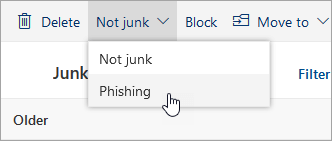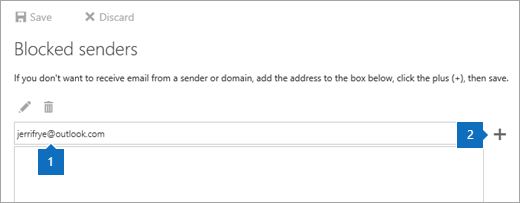Help keep spam and junk email out of your inbox in Outlook.com
If you're seeing an increase in spam and junk email, there are a number of ways to reduce the amount of spam that lands in your inbox.
Choose your version for instructions
The instructions are slightly different depending on whether or not you're using the Outlook.com beta. Choose which version of Outlook.com you're using to see the instructions that apply to you.
| IF YOUR MAILBOX LOOKS LIKE... | IF YOUR MAILBOX LOOKS LIKE... |
|---|---|
| | |
Instructions for the Outlook.com beta
Report junk email
When you move a message to the Junk Email folder, Outlook.com learns from that action to understand what kind of messages you consider to be junk. If you get an email that looks like spam or a phishing scam, report it.
-
Select the message you want to mark as spam or a phishing scam and select Junk on the command bar.

You can also right-click the message and select Mark as junk.
-
To mark a message as a phishing scam, go to the Junk Email folder, select the message, select Not junk > Phishing.

Instructions for classic Outlook.com
Report junk email
When you move a message to the Junk Email folder, Outlook.com learns from that action to understand what kind of messages users consider to be junk. If you get an email that looks like spam or a phishing scam, report it.
-
In your inbox, select the check box next to the message.
-
On the command bar, select the arrow next to Junk.

-
Select one of the following:
-
Junk Use this option for routine unwanted email.
-
Phishing scam Use this option for an email that is trying to trick you into giving out your personal information such as your password, bank account information, or Social Security number. To learn more, see Deal with abuse, phishing, or spoofing in Outlook.com.
-
My friend's been hacked Use this option if you start getting junk email or phishing scams from a sender you would normally trust.
-
Note: Legitimate businesses (including Microsoft) don't send unsolicited email messages to request personal or financial information. If you're suspicious about an email message, don't open a link or call the number in the message.
Junk email filters and reporting options
You can choose how much email Outlook.com filters, if content from unknown senders should be automatically blocked, and whether or not Microsoft is allowed to share your junk email reports with other companies that fight spam.
To set junk email filters and reporting options, go to Filters and reporting.
More ways to keep spam out of your inbox
Select the arrow to see more.
Share your email address only with people you know
Avoid posting your email address on your social networking site, in large Internet directories, and in job-posting websites. Don't even post it on your own website, unless you disguise it as described in "Disguise your email address", below.
Ignore junk email or instant messages
Spammers get rich (and build their contact lists, too) when people buy their "products." So don't reply to spam (even to unsubscribe), buy anything from an unfamiliar business, or agree to hold or transfer money for anyone. Beware of messages that appear to come from Microsoft and that ask for your password or threaten to close your account or expire your password. They're false.
To empty your Junk Email folder:
-
In the navigation pane, select Junk Email.
-
At the top of the screen, select Empty folder.

Add people to your safe senders list or to your blocked senders list
If you're receiving unwanted emails, you can block the people and domains you don't want to receive email messages from. Add any email address or domain to your blocked senders list to send these emails directly to your Junk Email folder. You can also add email addresses or domains to your safe senders list if you always want to receive messages from those senders.
Note: You can have up to 1,024 addresses or domains in the blocked senders and safe senders lists. If you want to add more than that, try blocking domains instead of individuals email addresses.
Add a person or domain to your blocked senders list
-
At the top of the screen, select Settings
 > Options > Mail > Junk email.
> Options > Mail > Junk email. -
Select Blocked senders, enter the email address or domain that you want to block, and select the Add icon
 .
.
Tip: To edit or remove emails or domains from the Blocked senders list, select the item in the list and then select Edit
 or Remove
or Remove  .
. -
Select Save
 .
.
Add a person or domain to your safe senders list
-
At the top of the screen, select Settings
 > Options > Mail > Junk email.
> Options > Mail > Junk email. -
Select Safe senders, enter the email address or domain you want to add, and select the Add icon
 . Email from addresses or domains on the safe senders list don't get moved to your junk folder.
. Email from addresses or domains on the safe senders list don't get moved to your junk folder.
Tip: To edit or remove emails or domains from the Safe senders list, select the item in the list and then select Edit
 or Remove
or Remove  .
. -
Select Save
 .
.
Choose a junk email filter
If Outlook.com identifies a message as possible junk email, it may automatically move it to the Junk Email folder. Any malware—potentially malicious software or code—is disabled.
Outlook.com offers two levels of filtering for junk email: Standard and Exclusive.
-
Standard does the typical amount of email filtering. Any message that the filter determines is junk is sent to your Junk Email folder.
-
Exclusive is very restrictive. It only trusts new messages that come from members of your Safe Senders list and your Safe mailing list. It also trusts alerts that you have signed up for and service announcements. All other messages are put in the Junk Email folder.
To change the level of junk email filtering, select Settings  > Options > Mail > Junk email > Filters and reporting.
> Options > Mail > Junk email > Filters and reporting.
Look for pre-selected check boxes
When you shop online, companies sometimes pre-select check boxes that indicate you agree that it's fine to sell or give your email address to responsible parties.
Be prudent about when to subscribe to email newsletters and about what kind of email messages you're willing to receive. Make sure you clear the check box if you don't want to be contacted.
Read the privacy policy
When you sign up for web-based services such as banking, shopping, or newsletters, carefully read the privacy policy before you reveal your email address so you don't unwittingly agree to share confidential information.
The privacy policy should outline the terms and circumstances regarding if or how the site will share your information. If a website doesn't post a privacy statement, consider taking your business elsewhere.
Disguise your email address
When you post to a message board, newsgroup, chat room, or other public webpage, spell out your entire email address, for example, jerrifrye AT outlook DOT com. This way, a person can interpret your address, but the automated programs that spammers use often can't.
Improve your computer's security
You can greatly reduce your risk from hackers, viruses, and worms if you have a firewall, keep your Windows and Microsoft Office software up to date, and install antivirus and antispyware software (and update all routinely).
Block content from unknown senders
-
At the top of the screen, select Settings
 > Options > Mail > Junk email.
> Options > Mail > Junk email. -
Select Filters and reporting, and under Block content from unknown senders, select Block attachments, pictures, and links from anyeone not in my Safe senders list.
Still need help?
Related Topics
Block senders or unblock senders in Outlook.com
Deal with abuse, phishing, or spoofing in Outlook.com
Handling junk in Mail for Windows 10




No comments:
Post a Comment